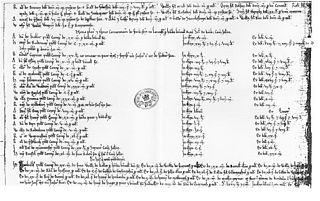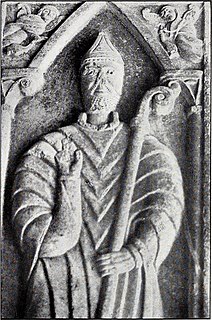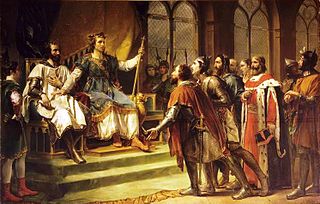Related Research Articles

John was King of England from 1199 until his death in 1216. He lost the Duchy of Normandy and most of his other French lands to King Philip II of France, resulting in the collapse of the Angevin Empire and contributing to the subsequent growth in power of the French Capetian dynasty during the 13th century. The baronial revolt at the end of John's reign led to the sealing of Magna Carta, a document sometimes considered an early step in the evolution of the constitution of the United Kingdom.
John de Gray or de Grey was an English prelate who served as Bishop of Norwich, and was elected but unconfirmed Archbishop of Canterbury. He was employed in the service of Prince John even before John became king, for which he was rewarded with a number of ecclesiastical offices, culminating in his pro forma election to Norwich in 1200. De Gray continued in royal service after his elevation to the episcopate, lending the King money and undertaking diplomatic missions on his behalf. In 1205 King John attempted to further reward de Gray with a translation to the archbishopric of Canterbury, but a disputed election process led to de Gray's selection being quashed by Pope Innocent III in 1206.

In the civil service of the United Kingdom, Her Majesty’s Exchequer, or just the Exchequer, is the accounting process of central government and the government's current account in the Consolidated Fund. It can be found used in various financial documents including the latest departmental and agency annual accounts.
In Middle Ages in England and Scotland the Chief Justiciar was roughly equivalent to a modern Prime Minister of the United Kingdom as the monarch's chief minister. Similar positions existed in continental Europe, particularly in Norman Italy and in the Carolingian Empire. The term is the English form of the medieval Latin justiciarius or justitiarius.
Richard de Clare, 2nd Earl of Pembroke, Lord of Leinster, Justiciar of Ireland, also known as Richard FitzGilbert, was an Anglo-Norman nobleman notable for his leading role in the Anglo-Norman invasion of Ireland. Like his father, Richard fitz Gilbert has since become commonly known by his nickname Strongbow, which may be a mistranscription or mistranslation of "Striguil."
The Provisions of Oxford were constitutional reforms developed in 1258 which resolved a dispute between the English barons and King Henry III of England. They asserted the right of the barons to representation in the king's government and, like the earlier Magna Carta, demonstrated the ability of the barons to press their concerns in opposition to the monarchy.
The Revolt of 1173–74 was a rebellion against King Henry II of England by three of his sons, his wife Eleanor of Aquitaine, and their rebel supporters. The revolt ended in failure after eighteen months; Henry's rebellious family members had to resign themselves to his continuing rule and were reconciled to him.
Hugh de Puiset was a medieval Bishop of Durham and Chief Justiciar of England under King Richard I. He was the nephew of King Stephen of England and Henry of Blois, who both assisted Hugh's ecclesiastical career. He held the office of treasurer of York for a number of years, which led him into conflict with Henry Murdac, Archbishop of York. In 1153, Hugh was elected bishop of Durham despite the opposition of Murdac.
The Assize of Northampton, largely based on the Assize of Clarendon of 1166, is among a series of measures taken by King Henry II of England that solidified the rights of the knightly tenants and made all possession of land subject to and guaranteed by royal law.

The Pipe rolls, sometimes called the Great rolls, or the Great Rolls of the Pipe are a collection of financial records maintained by the English Exchequer, or Treasury, and its successors. The earliest date from the 12th century, and the series extends, mostly complete, from then until 1833. They form the oldest continuous series of records concerning English governance kept by the English, British and United Kingdom governments, covering a span of about 700 years. The early medieval ones are especially useful for historical study, as they are some of the earliest financial records available from the Middle Ages. A similar set of records was developed for Normandy, which was ruled by the English kings from 1066 to 1205, but the Norman Pipe rolls have not survived in a continuous series like the English.

Bowes Castle is a medieval castle in the village of Bowes in County Durham, England. Built within the perimeter of the former Roman fort of Lavatrae, on the Roman road that is now the A66, the early timber castle on the site was replaced by a more substantial stone structure between 1170 and 1174 on the orders of Henry II. A planned village was built alongside the castle. Bowes Castle withstood Scottish attack during the Great Revolt of 1173–74 but was successfully looted by rebels in 1322. The castle went into decline and was largely dismantled after the English Civil War. The ruins are now owned by English Heritage and run as a tourist attraction. There is free admission during daylight hours.

Hilary (c. 1110–1169) was a medieval Bishop of Chichester in England. English by birth, he studied canon law and worked in Rome as a papal clerk. During his time there, he became acquainted with a number of ecclesiastics, including the future Pope Adrian IV, and the writer John of Salisbury. In England, he served as a clerk for Henry of Blois, who was the Bishop of Winchester and brother of King Stephen of England. After Hilary's unsuccessful nomination to become Archbishop of York, Pope Eugene III compensated him by promoting him to the bishopric of Chichester in 1147.

Bartholomew Iscanus was a medieval Bishop of Exeter. He came from Normandy and after being a clerk of the Archbishop of Canterbury, was made Archdeacon of Exeter in 1155. He became bishop of Exeter in 1161. He was known as having excellence in canon law and theology and during his time as bishop visited all the parishes in the diocese to investigate how well-managed they were.
Carucage was a medieval English land tax enacted by King Richard I in 1194, based on the size—variously calculated—of the taxpayer's estate. It was a replacement for the danegeld, last imposed in 1162, which had become difficult to collect because of an increasing number of exemptions. Carucage was levied just six times: by Richard in 1194 and 1198; John, his brother and successor, in 1200; and John's son, Henry III, in 1217, 1220, and 1224, after which it was replaced by taxes on income and personal property.
The Close Rolls are an administrative record created in medieval England by the royal chancery, in order to preserve a central record of all letters close issued by the chancery in the name of the Crown.
Urse d'Abetot was a Norman who followed King William I to England, and became Sheriff of Worcestershire and a royal official under him and Kings William II and Henry I. He was a native of Normandy and moved to England shortly after the Norman Conquest of England in 1066, and was appointed sheriff in about 1069. Little is known of his family in Normandy, who were not prominent. Although Urse's lord in Normandy was present at the Battle of Hastings, there is no evidence that Urse took part in the invasion of England in 1066.

The Mise of Amiens[miz ɒv a.mjɛ̃] was a settlement given by King Louis IX of France on 23 January 1264 in the conflict between King Henry III of England and his rebellious barons, led by Simon de Montfort. Louis' one-sided decision for King Henry led directly to the hostilities of the Second Barons' War.

Henry II, also known as Henry Curtmantle, Henry FitzEmpress or Henry Plantagenet, was King of England from 1154 until his death in 1189. He was the first king of the House of Plantagenet. King Louis VII of France made him Duke of Normandy in 1150. Henry became Count of Anjou and Maine upon the death of his father, Count Geoffrey V, in 1151. His marriage in 1152 to Eleanor of Aquitaine, whose marriage to Louis VII had recently been annulled, made him Duke of Aquitaine. He became Count of Nantes by treaty in 1185. Before he was 40 he controlled England, large parts of Wales, the eastern half of Ireland and the western half of France; an area that was later called the Angevin Empire. At various times, Henry also partially controlled Scotland, Wales and the Duchy of Brittany.
In medieval England, avera and inward were feudal obligations assessed against a royal demesne. The terms refer to various services rendered to the crown in lieu of payment in coin. Avera is connected with carrying items by horse, or possibly ploughing or both. Inward is probably the provision of a bodyguard during a royal visit: in Anglo-Saxon England it could be claimed by a sheriff. The services could usually be commuted to a monetary payment: in Hertfordshire avera could be commuted for fourpence. The services were usually found in the eastern counties, especially Cambridgeshire and Hertfordshire, due from sokemen. In Hertfordshire, inward is found only in the manor of Hitchin.
Reginald de Warenne was an Anglo-Norman nobleman and royal official. The third son of an earl, Reginald began his career as an administrator of his brother's estates and married the heiress to the feudal barony of Wormegay in Norfolk. By the reign of King Henry II in 1154, Reginald was a royal justice; he played a minor role in the Becket controversy in 1170. He died in 1179 and left a son as well as several daughters.
References
- ↑ Musson 2001 , p. 104; Warren 2000 , p. 252
- ↑ Warren 2000 , p. 252
- ↑ Warren 2000 , pp. 252, 291
- ↑ Warren 2000 , p. 287
- ↑ Warren 2000 , pp. 287–288
- ↑ Warren 2000 , p. 288
- ↑ G.O. Sayles. the Medieval Foundations of England (London 1967) p. 329
- ↑ 'The Deeds of Henry II', in D. Baker ed., The Early Middle Ages (London 1968) p. 148
- ↑ Warren 2000 , p. 291
- ↑ W. A. Morris, The Medieval English Sheriff (Manchester 1968) p. 113
- ↑ J. R. Tanner ed., The Cambridge Medieval History Vol V (Cambridge 1926) p. 581
- ↑ Warren 2000 , pp. 290–291
- ↑ J. R. Tanner ed., The Cambridge Medieval History Vol V (Cambridge 1926) p. 582